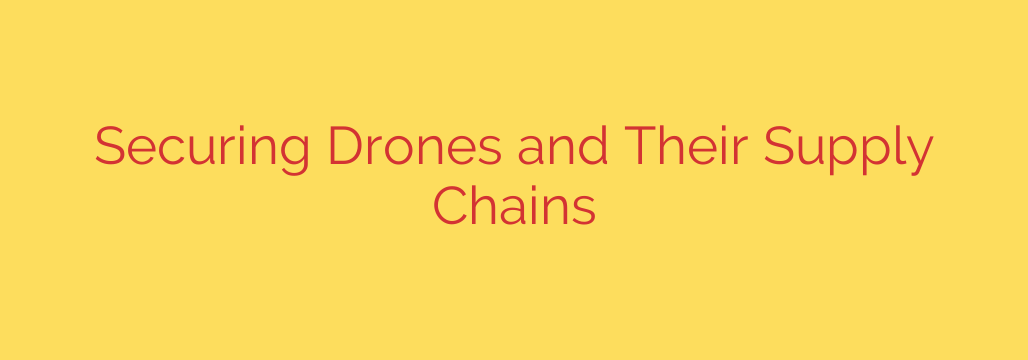
Beyond the Cockpit: A Guide to Drone Security and Supply Chain Integrity
Drones, or Unmanned Aerial Systems (UAS), have rapidly evolved from niche gadgets to indispensable tools across industries like logistics, agriculture, public safety, and critical infrastructure inspection. As their capabilities expand, so does their integration into sensitive operations. However, this rapid adoption often outpaces the implementation of robust security measures, leaving organizations vulnerable to significant risks that extend far beyond a simple crash.
The security of a drone is not just about its flight path; it’s about the data it carries, the systems it connects to, and the integrity of every component it’s built with. A comprehensive approach to UAS security must address both the device itself and its entire supply chain.
Identifying Key Drone Vulnerabilities
An unsecured drone is a liability waiting to happen. Hostile actors can exploit numerous vulnerabilities to disrupt operations, steal sensitive information, or even cause physical damage. Understanding these weak points is the first step toward building a strong defense.
Unencrypted Data Links: Many off-the-shelf drones transmit video feeds and command-and-control data over unencrypted radio links. This allows attackers to easily intercept, monitor, or even manipulate the data stream—a practice known as “drone hijacking.” Sensitive information, such as surveillance footage of a secure facility, can be stolen mid-air.
GPS and Sensor Spoofing: Drones rely heavily on GPS for navigation and stabilization. Attackers can transmit false GPS signals, tricking the drone into thinking it is somewhere else. This can be used to divert a drone, force it to land in an unauthorized location, or cause it to crash. Spoofing attacks can disrupt critical missions and lead to the loss of valuable assets.
Firmware and Software Exploits: Like any connected device, a drone’s software can have vulnerabilities. Hackers can exploit these flaws to install malware, gain control of the aircraft, or access its onboard data storage. Failure to regularly patch and update drone firmware from trusted sources is a major security oversight.
The Hidden Danger: The Drone Supply Chain
Even a drone with perfect software and encrypted communications can be compromised before it ever takes flight. The global supply chain for electronics is complex, creating numerous opportunities for malicious components or backdoors to be introduced during manufacturing or assembly.
The security of your drone is only as strong as the weakest link in its supply chain. A single compromised microchip, sensor, or software module can create a hidden vulnerability that is nearly impossible to detect with standard security scans. This component could be designed to fail at a critical moment, exfiltrate data to a foreign server, or grant an attacker persistent access to your network.
This is why understanding the origin of your drone’s components and software is crucial. Geopolitical risks play a significant role here, as hardware or software sourced from adversarial nations may be subject to state-sponsored mandates that require manufacturers to build in backdoors for espionage or sabotage.
Actionable Steps to Secure Your Drone Operations
Protecting your drone fleet requires a multi-layered strategy that combines technology, policy, and due diligence. Simply relying on the manufacturer’s default settings is not enough.
Prioritize Secure Procurement and Vendor Vetting: When acquiring new drones, go beyond flight specs and battery life. Ask potential suppliers detailed questions about their supply chain security, component sourcing, and data management practices. For government and enterprise applications, prioritize drones that are compliant with regulations like the National Defense Authorization Act (NDAA), which restricts the use of certain foreign-made systems.
Implement Robust Operational Security Protocols: Create and enforce a strict security policy for all drone operations. This should include:
- Strong authentication and access controls for ground control stations and software.
- Regularly updating firmware from verified, official sources.
- Keeping drones on a segmented network isolated from your primary business IT infrastructure.
- Physically securing drones and storage media when they are not in use to prevent tampering.
Choose Drones with Security-by-Design: Look for UAS platforms that are built with security as a core feature, not an afterthought. Key features include end-to-end encryption for all data links (video, command, and telemetry), secure boot processes to prevent firmware tampering, and robust data protection for onboard storage.
As drones become more autonomous and integrated into our daily lives, the need for a security-first mindset is non-negotiable. By addressing vulnerabilities in both the aircraft and its supply chain, organizations can harness the power of this technology while protecting their assets, data, and operations from emerging threats.
Source: https://www.helpnetsecurity.com/2025/09/25/drones-cybersecurity-risks/








